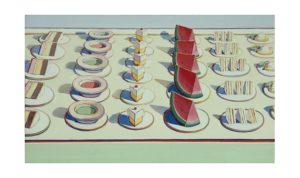It has been awhile since we did the last design class. There is no podcast accompaniment, but if one becomes available, I’ll come back to this post and link to it. Gradation was the last installment that I could find. You can find the entire series by clicking on the ‘Design Series’ tag in any of the relevant posts.
I want to finish the series as the unposted final classes niggle at the back of my mind like a to do list item I cannot cross off.
Dominance is related to Emphasis/Focal Point
Dominance is a Principle of Design
Definitions:
- One element plays the dominant role in a design. (Adventures in Design, pg.106)
- Medallion quilt
- Focus fabric
- “Dominance gives interest to one entity or area of a design over the others.” (Fiber Artist’s Guide to Color & Design, pg. 199)
- “Dominance gives a painting interest, counteracting confusion and monotony. Dominance can be applied to one or more of the elements to give emphasis (John Lovett)
Notes:
- The difference between focal point and dominance is subtle. An element that dominates because of size or color, etc can also be a focal point, but it is not a focal point when your attention is drawn to one spot, but then drifts away because something else is going on in the design field that could be considered as dominant or only slightly less dominant than the element that could be the focal point, if not for the other aspect of the design field. Look at page 125 of A Fiber Artist’s Guide to Color & Design by Heather Thomas for an example.
- “Both Dominance and Emphasis give interest to one entity or area over others present in a design field, however a focal point is not always formed. Giving dominance to , or emphasizing one design element or area will counteract confusion or the risk of monotony. (Fiber Artist’s Guide to Color & Design, pg. 125)
Using Dominance
- Dominance “can be achieved through the use of color, value, intensity, size and scale as well as other design elements. Emphasizing one element or letting one area dominate others sends an invitation to the viewer to come in and take a closer, longer look at the work.” (Fiber Artist’s Guide to Color & Design, pg. 125)
- The elements, line, shape, texture, form, are like the actors in a play. Not all the actors can be the star. You have to chose who will be the lead. When you choose who will be the lead in your quilt design, you are deciding which element will have dominance and you are enhancing visual unity. You can select another element to be your supporting actor and additional elements to play lesser roles to lend “visual support to your design.” (Adventures in Design, pg.106)
Resources
- Adventures in Design, Joen Wolfrom
- Fiber Artist’s Guide to Color & Design, Heather Thomas
- John Lovett Design and Color: http://bit.ly/JON8sh
